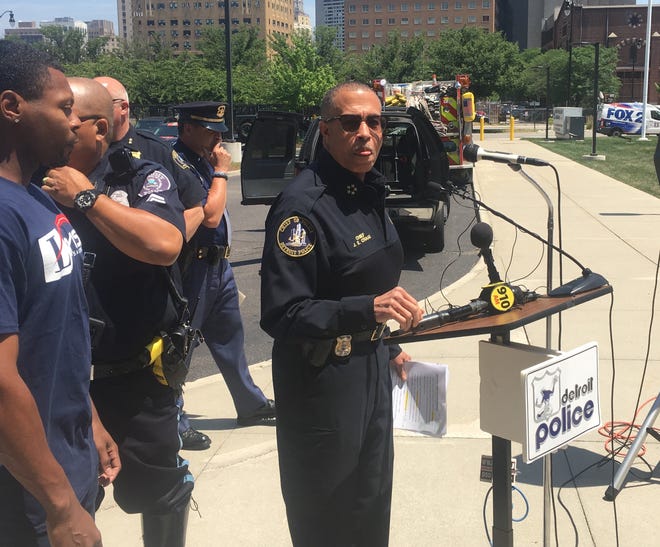Craig promotes $4M expansion of real-time technology amid privacy worries
 Christine Ferretti
Christine Ferretti
Detroit — Police Chief James Craig made his pitch Monday for a $4 million expansion of the city's Real Time Crime Center amid community privacy concerns, stressing it's "about the business of reducing violence."
Craig detailed the department's reasoning for the build-out during a Detroit City Council Public Health and Safety subcommittee session before members voted to move the three-year contract to the full body for a final vote later this month.
The plan would expand the existing crime center at Detroit's public safety headquarters as well as add two mini precinct-based centers in the 8th and 9th precincts. It comes amid tension over the growing use of surveillance technology in Detroit and controversial facial recognition software.
“This is about the business of reducing violence," Craig told council members on Monday, adding when the cameras are deployed he's confident "we will see a reduction."
Detroit has 568 locations in Project Green Light, an initiative launched several years ago that allows police to monitor real-time video feeds from gas stations, restaurants, stores and other city businesses.
During his annual State of the City speech this spring, Mayor Mike Duggan touted plans that would allow police to tap into video from cameras mounted on city traffic lights as an additional crime-fighting measure.
Green Light has "grown well beyond our expectations," Craig said. With the department's goal of making the city safer, officials realize they have outgrown the current real-time crime operation, he said.
"We know when we have the use of video technology we can go back at the time of the shooting ... and have a higher probability of solving that crime," Craig said. "We believe, just like with Green Light, suspects engaging in that behavior will engage in other decisions."
During a public comment period, Detroit activist Elena Herrada said she adamantly opposes any money being used for surveillance contracts.
"They are putting $4 million into facial recognition equipment and trying to say they are not going to use it for arresting people," Herrada told The Detroit News after the session. "In the meantime, no resources are going into neighborhoods. ... They don't have anything going for the people. They are trying to turn us into a police state."
Councilman Scott Benson, who chairs the public health and safety committee, said facial recognition software has become a "passionate debate" in the city and inquired whether it was a factor in the crime center expansion.
When The News reported plans for the facial recognition software in October 2017, police officials said it would be used in conjunction with the Green Light program. But Craig has since said the software is not part of Green Light.
On Monday, the police chief told Benson that it "plays no role at all" in the proposed real-time crime center contract and isn't embedded in other technologies the city deploys, like Green Light or city traffic cameras.
It's another tool, Craig said, like a composite sketch or surveillance photos put out to generate tips which are then vetted by the department.
"Facial recognition is a stand-alone technology," he said. "It's only a tool. Facial recognition can never be used to make arrests based on probable cause."
Detroit's use of facial recognition software, which has been employed for about a year, has prompted intense debate. On Thursday, elected Police Commissioner Willie Burton was arrested for allegedly disrupting the commissioners' board meeting where the audience was irate over the topic.
The police board has been discussing a proposed policy that would govern use of the software, which officials say restricts using the technology to after-the-fact investigations of violent crimes, or when there's a credible threat of terrorism. The proposal was removed from Thursday's meeting agenda at Craig's request for minor changes.
Council President Pro Tem Mary Sheffield has drafted an ordinance for government surveillance technology that would call for public engagement and specifics on how and why a technology would be used, before council votes on a proposal. It also would require annual reporting on collected data, she said.
The facial recognition software that the city approved in 2017 can be used to analyze data captured by Green Light, traffic light and other technologies, Sheffield said. She is awaiting data from the Police Department to determine how often the software has been used so far and whether it has helped solve crimes.
"I'm concerned about the studies I've read thus far about its reliability and its ability to properly read people of color," said Sheffield, who did not support the contract in 2017.
Benson on Monday further expressed the worries of some residents over more cameras being deployed in neighborhoods.
"Why should we have a level of confidence that this level of authority in the hands of the government, with guns, will not be abused?" Benson asked the police chief.
The department regularly addresses such concerns, Craig said, but the technology isn't intended to encroach on private property, peer into cars or "use for other nefarious reasons."
If any technology is used improperly, employees will be held accountable through discipline, he said.
Detroit Building Authority Director Tyrone Clifton noted Monday that the build-out of the existing 2,400-square-foot center and the new mini centers are part of a capital project. The building authority is prepared, Clifton said, to award the contract and "get going as soon as possible."
The Real Time Crime Center expansion proposal is expected to go before the full Detroit council on July 23.
cferretti@detroitnews.com